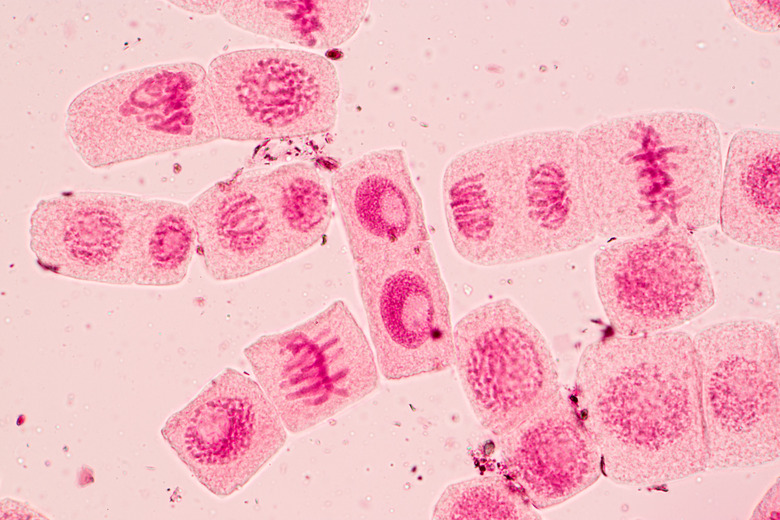What Happens When Mitosis Goes Wrong?
When a cell divides, it creates two identical daughter cells that each carry a copy of the original cell's DNA. The name for this process is mitosis, and errors in the process result in incorrect DNA copies. The effects of these errors on the health of the organism range from benign to deadly, depending on their number errors and type. One potential consequence is cancer; scientists trace all cancer types back to harmful mutations multiplied by mitosis.
Mitosis and Cancer
Mitosis and Cancer
DNA, sometimes called a genetic blueprint, contains the hereditary material in nearly all organisms. The improper copying of DNA produces two types of errors, or mutations. Silent mutations have no impact on the DNA sequence, but missense mutations, which alter amino acid sequences, often impact the associated function. Missense mutations can multiply over time, leading to cell cycle disruption and the formation of tumors , which are the product of runaway cell reproduction. Cancer occurs when mutated cells ignore or override the normal "checkpoints" regulating mitosis and begin to reproduce uncontrollably.
Chromosome Abnormalities
Chromosome Abnormalities
The process of mitosis generates identical daughter cells by arranging chromosomes into two equal groups. When the process occurs normally, chromosomes attach to string-like spindles and begin to move to the middle of each daughter cell. If chromosomes fail to attach to these spindles, however, a daughter cell might have an extra copy of a chromosome after the cell divides, or it might be missing one. Scientists refer to the condition whereby cells have an incorrect number of chromosome as aneuploidy. Down syndrome, which is characterized by specific facial features and higher susceptibility to certain diseases like Alzheimer's and leukemia, is one disorder caused by the presence of an extra chromosome.
Effects on Organelles
Effects on Organelles
Supersession of the mitotic checkpoints in cancer cells causes runaway damage to the cell's organelles, which are units within the cells that carry out specific functions. During normal mitosis, damaged organelles have a chance to repair and recover between cell divisions, but they don't have this opportunity when cell division doesn't stop. Cells with damaged organelles can die. According to a 2012 study, leakage from damaged mitochondria, which are organelles that provide energy to the cell, can trigger the release of "executioner" enzymes.
Mosaicism
Mosaicism
Cell mutations within an individual aren't always uniform; some cells may have a mutant version of a gene while others have the normal version of the same gene. Geneticists refer to this condition as mosaicism. In somatic cells, or cells other than egg or sperm cells, the individual may not be affected by the mutations, but if the mutant genotype is widespread and harmful enough, the mutation can have a major impact. Two examples of diseases linked to mosaicism are hemophilia, a blood-clotting disorder, and Marfan syndrome, which produces unusually long limbs.
Cite This Article
MLA
Auerbach, Scott. "What Happens When Mitosis Goes Wrong?" sciencing.com, https://www.sciencing.com/happens-mitosis-goes-wrong-8400/. 13 March 2018.
APA
Auerbach, Scott. (2018, March 13). What Happens When Mitosis Goes Wrong?. sciencing.com. Retrieved from https://www.sciencing.com/happens-mitosis-goes-wrong-8400/
Chicago
Auerbach, Scott. What Happens When Mitosis Goes Wrong? last modified March 24, 2022. https://www.sciencing.com/happens-mitosis-goes-wrong-8400/
